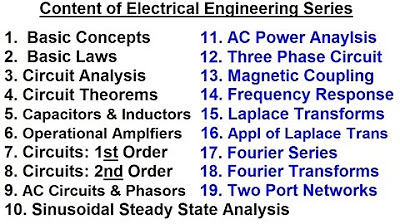Introduction to Signals and Systems
Summary
TLDRIn the first lecture of the Signals and Systems series, the instructor outlines a comprehensive syllabus that includes essential topics such as signal definitions, basic operations, system properties, and various analyses like Fourier and Laplace transforms. The lecture emphasizes the distinction between signals and constant values, categorizes signals into single-variable and multi-variable types, and introduces the concept of systems as interconnected devices that process input signals to generate desirable outputs. It also explains analysis and synthesis problems, highlighting their importance in understanding system responses. The session concludes with a preview of the next topic on continuous-time and discrete-time signals.
Takeaways
- 📚 The syllabus of the course on signals and systems is divided into ten parts, covering topics from basic definitions to advanced transforms.
- 🔍 A signal is defined as a dependent variable or function of one or more independent variables.
- ⚡ The difference between a signal and a DC value is that a signal varies with time, while a DC value remains constant.
- 🔢 Signals can be classified into two types: single variable signals, which depend on one variable, and multi-variable signals, which depend on multiple variables.
- 🔧 A system is a meaningful interconnection of physical devices and components, which cannot function alone without input.
- 💡 The input signal must be processed by the system to produce a more desirable output signal.
- 🛠️ Systems can be analyzed through two types of problems: analysis problems (finding output from input) and synthesis problems (finding a system from input and output).
- ⚖️ The desirability of a signal can vary based on the context; for example, mechanical work may be more desirable than electricity in specific scenarios.
- 📝 The course will primarily focus on analysis problems, where the response of a system to an input signal will be computed.
- 🔜 Upcoming lectures will cover continuous-time signals and discrete-time signals.
Q & A
What is the main focus of the lecture series on signals and systems?
-The lecture series aims to introduce the fundamental concepts of signals and systems, covering definitions, classifications, operations, and properties of signals and systems.
How is the syllabus of the course structured?
-The syllabus is classified into ten parts, including basic definitions, operations on signals, system properties, time domain analysis, Fourier series and transform analysis, Laplace and Z transforms, sampling theorem, and random signals.
What is the definition of a signal as per the lecture?
-A signal is defined as a dependent variable or function of one or more independent variables.
What distinguishes a signal from a DC value?
-A signal is characterized by its variability with respect to independent variables, while a DC value remains constant and does not change with time.
What are the two types of signals discussed in the lecture?
-The two types of signals are single variable signals, which depend on one variable, and multi-variable signals, which depend on more than one variable.
Can you explain what constitutes a system in the context of signals and systems?
-A system is defined as a meaningful interconnection of physical devices and components that processes signals to achieve a specific task.
What is the role of an input signal in a system?
-The input signal is processed by the system to produce an output signal that is typically more desirable for the intended application.
What are the two main types of problems related to signals and systems?
-The two main types of problems are analysis problems, where the input signal and system are known and the output signal is to be found, and synthesis problems, where the input and output signals are known and the system needs to be determined.
What is an example of a single variable signal mentioned in the lecture?
-An example of a single variable signal is a function that depends solely on time, represented as f(t).
How does the lecture differentiate between the desirability of input and output signals?
-The desirability of input and output signals depends on the specific task; in some cases, an input signal may be less desirable than the output signal, while in other scenarios, the opposite may be true.
Outlines

Cette section est réservée aux utilisateurs payants. Améliorez votre compte pour accéder à cette section.
Améliorer maintenantMindmap

Cette section est réservée aux utilisateurs payants. Améliorez votre compte pour accéder à cette section.
Améliorer maintenantKeywords

Cette section est réservée aux utilisateurs payants. Améliorez votre compte pour accéder à cette section.
Améliorer maintenantHighlights

Cette section est réservée aux utilisateurs payants. Améliorez votre compte pour accéder à cette section.
Améliorer maintenantTranscripts

Cette section est réservée aux utilisateurs payants. Améliorez votre compte pour accéder à cette section.
Améliorer maintenantVoir Plus de Vidéos Connexes
5.0 / 5 (0 votes)






